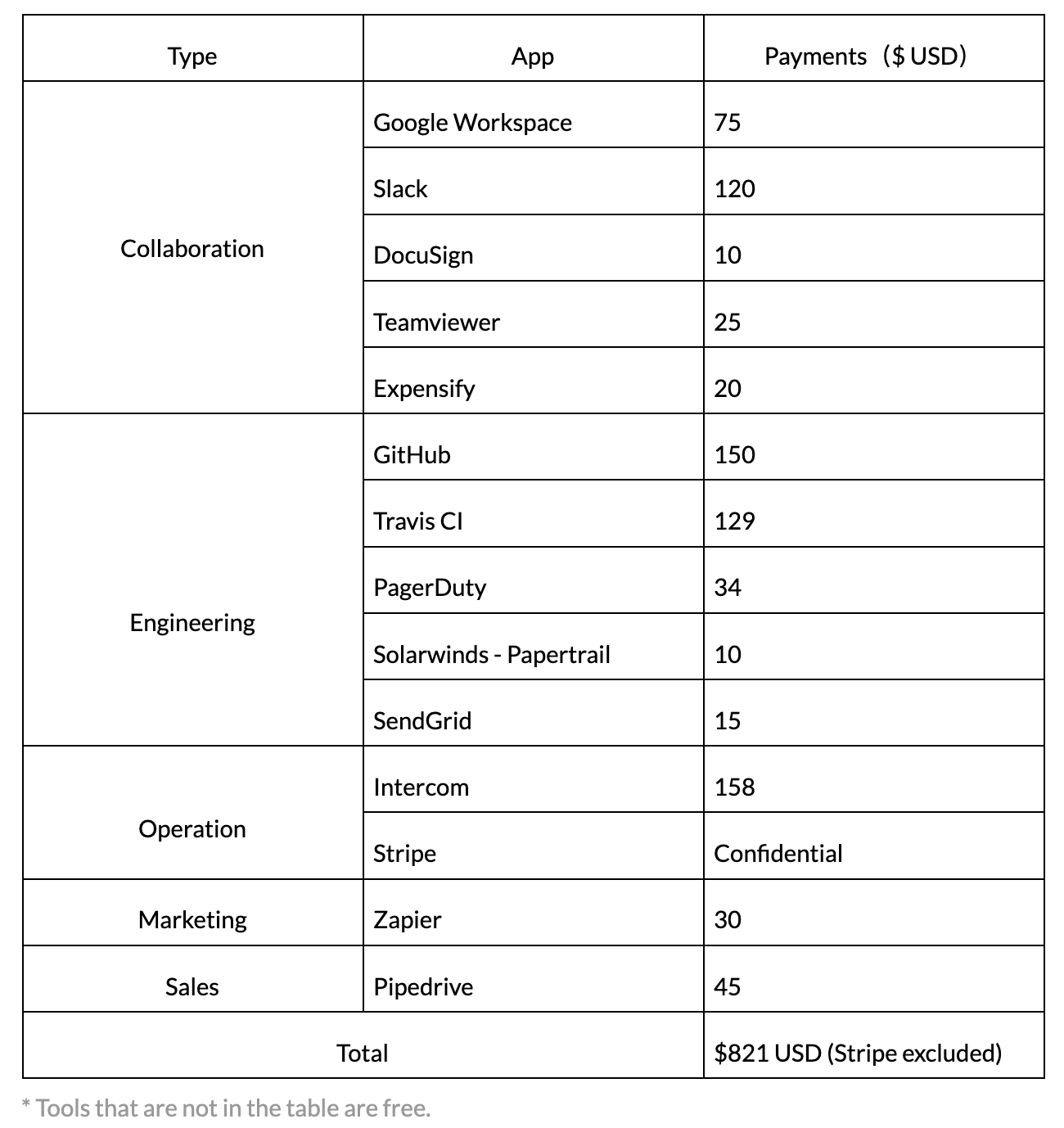Let’s face it: acquiring enough customers to break even might take months or years for startups. When Juicedata, an open-source software company, was founded, we asked ourselves: “How long will it take to launch our first product?” and “How many employees do we need to keep the business afloat?” Though we could not come up with answers with exact numbers at that time, we sort of knew what we wanted—a lean team with high efficiency. Luckily, we have hit several milestones with a few staff.
In this article, I will share 20+ SaaS tools that helped us stay focused and productive while also providing cost-saving benefits over the past five years. Regardless of where your company is currently at—building a minimum viable product (MVP), achieving Product-Market-Fit (PMF), building the team to scale, or expanding to other markets or regions—I hope you will find some worth trying.
Quick summary
- The early stage of starting a business
- Teamwork: Google Workspace
- Message center: Slack
- Electronic contract: DocuSign
- Reimbursement: Expensify
- Turning ideas into products
- Code and Project management: GitHub
- CI: Travis CI + GitHub Actions
- Payment: Stripe
- Mail service: SendGrid
- Releasing the product
- Customer service: Intercom
- Alerting: PagerDuty
- Log service: Solarwinds - Papertrail
- Connecting with customers
- CRM: Pipedrive
- Tools for online meetings
- Tools for communication
- Remote Desk: TeamViewer
- Growing with the open source community
- Community operation: Orbit
- Traffic analysis: Google Analytics + Google Search Console
- Maillist: Mailchimp
- An all-purpose automation tool: Zapier
Choosing the right tool
Here are the fundamental principles that guide us when choosing the tool:
- Global: Juicedata aims to deliver products for the global market, so selecting tools that are widely used around the world will facilitate collaboration with colleagues in different countries and regions. Additionally, there are many options and full integration support available with the long-established, global SaaS tools. However, there are times when using localized tools is preferable, and we will go through? with those.
- Effective: Managing business expenses doesn’t require cutting costs whenever possible. We are more than willing to pay for the tool's services as long as it can make us more productive with a consistent user experience.
- Cloud-based: To reduce operational maintenance costs, we favor cloud-based applications over those that are privately deployed or homegrown open-source products.
- Easy to use: The tools must be user-friendly. Spending excessive time reading tutorials or documentation to get started won’t help us get things done quickly.
- Minimalistic: Just as minimalism is crucial to product design, it also applies to tool selection. If a tool with fewer features could precisely cover our needs, a one-stop solution would be impractical.
The early stage of starting a business
Back in 2017, we just started our business. Effective collaboration and communication are urgently needed at this time, so Home Office was our first option.
Teamwork: Google Workspace
Price: $6/account/month
It comes as no surprise that many startups or enterprises use Google Workspace as their collaboration hub. Truth be told, I can’t imagine how our work would be done without it. Google Workspace integrates meetings, files, and other apps that not only streamline common workflows but also make teamwork more flexible.
Message center: Slack
Price: $8/account/month
Slack is more than just an instant message (IM) platform. With a central hub that’s customizable to our specific needs, we are now able to ensure communication transparency while finding and resolving issues faster. For example, with integrations, we can receive actionable notifications of
- new issues, PR, and CI results in GitHub Repos
- PagerDuty alert
- file updates in Google Drive
- sales updates in Pipedrive
- business status of our cloud services (we developed a bot via Slack API)
A finer level of configuration is possible for the notifications, allowing us to choose the recipient and filter out irrelevant information without losing sight of important messages. After JuiceFS was open-sourced in 2021, we also use Slack to bond with community members.
Electronic contract: DocuSign
Price: $15/account/month
Despite having a team of employees from different countries and serving customers from all over the world, we haven’t sent any hardcopy contracts over the past few years. A cross-border express typically takes more than 10 days to deliver, and especially during the epidemic, the wait time was significantly longer with a risk of loss. Electronic contracts, on the other hand, are far more effective and almost instantly available. It is no longer necessary to pay a dedicated employee to handle contract management and archiving, as it was in the past, because DocuSign offers these functions as well.
Reimbursement: Expensify
Price: $20/account/month
Expensify is a tool for expense management. We can import the credit card transactions onto it, which will then generate a report for reimbursement. By working with third-party agencies, Expensify can also be used for Juicedata's annual tax return, saving a ton of time and effort. Aside from reimbursement, it also helps to control employee expenses.
Turning ideas into products
It can take years to turn an idea into a finished product, but with the correct tools, the process can be sped up. Below are some useful tools that software engineers might find helpful at work.
Code and Project management: GitHub
Price: $4/account/month
Due to security concerns and a desire to tailor the platform to their scalability requirements, some companies might deploy a GitLab repo on their own. But we chose GitHub because we think convenience is more important.
GitHub offers various services apart from version control. GitHub has the largest community of developers in the world, which is definitely a good platform for cooperation and communication with developers. Specifically, we use GitHub Issue and Project for project management and GitHub Wiki for knowledge management. Another advantage of GitHub is that both public and private projects use the same set of tools and follow the same process, making switching between different projects quite inexpensive.
CI: Travis CI + GitHub Actions
Price:
- Travis CI: 5 concurrencies, $249/month
- GitHub Actions: Free for open-source projects
We have been using a SaaS-based CI service and haven’t made any extra effort into CI for several years. We initially used Travis CI before switching to GitHub Actions after it was released. Currently, we use both tools at Juicedata.
Payment: Stripe
Price: 2.9 % + $ 0.3 per successful card charge
JuiceFS Cloud Service is pay-as-you-go. Recognizing the usability and popularity of Stripe, we integrated JuiceFS Cloud Service with Stripe to offer a secure and frictionless payment experience. When working with corporate accounts, Stripe is also used to manage bills and track payment status. For other process management such as invoices, we usually use Google Forms.
Mail service: SendGrid
Price: $14.95/month
SendGrid is a proven cloud-based customer communication platform that allows you to send emails without having to maintain email servers. We use SendGrid to send emails for JuiceFS Cloud Service, such as emails that inform users of registration, account activation, and password recovery. Because some Chinese email providers might block emails from SendGrid, we also use SendCloud as a supplement to send emails to Chinese users.
Releasing the product
After we launched JuiceFS Cloud Service, our flagship product, in 2017, the next question is how to drive conversion rate and customer satisfaction.
Customer service: Intercom
Price: $74/month
After doing some research on customer service platforms, we decided to use Intercom without hesitation.
The initial idea was to display a live chat window on our website. Soon we find it even possible to configure a conversation template for automatic replies, which would significantly improve efficiency and enhance user engagement. By connecting the Intercom API with JuiceFS user accounts, we can leverage automated emails. Intercom makes it incredibly easy to send mass emails about product updates, customer stories, and so on.
On a side note: I am deeply impressed by Intercom’s content marketing strategy. Honestly speaking, I even enjoy watching its email campaign and have read all the e-books Intercom issued. This makes me believe that a company that can communicate and interact with users so well must also be able to produce great communication and marketing products.
Alerting: PagerDuty
Price: $34/account/month
Different from normal SaaS applications, JuiceFS Cloud Service needs to be deployed in each cloud region, which poses challenges for Site Reliability Engineers (SREs). Therefore, it is not wise to build an alarm system for such services on our own. PagerDuty greatly simplifies the process. It can send notifications whenever there are alarms: WARNING or CRITICAL. Depending on the severity, we will be notified either through Slack or through SMS and phone call.
Log service: Solarwinds - Papertrail
Price: 10GB, $10/month
Although all major public cloud providers offer native log monitoring services, they are less efficient for JuiceFS because it needs to be deployed on dozens of public clouds, making it troublesome to learn each of the service logs.
Solarwinds - Papertrail allows us to search real-time logs of all service nodes in the world via a unified interface, which is very helpful for analyzing problems of distributed systems. Moreover, through keywords configuration, we can also be promptly notified in Slack when an exception occurs.
Connecting with customers
Now here comes the real hard work. It took us three years to iterate JuiceFS and find its product-market fit. During these iterations, the size of our customers has grown from startups to listed companies, and the user scenarios have also gradually changed from data backup to building data lakes on the cloud.
CRM: Pipedrive
Price: $19.9/account/month
We used Salesforce to manage the sales process at first. It is a powerful tool with a strong reputation in the market, yet it might be too powerful (or perhaps over-complicated) for startups with limited sales data. So, six months later, we switched to Pipedrive, a sales platform that puts simplicity and efficiency as its main advantage. It mainly satisfies the following requirements:
- Contact management. The sales process usually involves quite some roles. This means that we need to streamline the workflow and fully harness contact data. For example, when we discuss complex issues with customers, it would be great to keep track of all meetings and notes associated with every deal and contact.
- Sales funnel management. Winning customers is not an easy task and behind every closed deal is an opportunity for us to optimize lead generation and the customer journey.
I am also surprised by Pipedrive’s clear visual interface, which enables us to see all sales pipelines at a glance, and prompts us to take action accordingly.
Tools for online meetings
More people now prefer online meetings to in-person meetings since remote working has become the "new normal." According to my experience, customers use various online meeting tools. Instead of asking them to install the tools we have, I will choose the one that is the most convenient for them, including Zoom, Lark, Microsoft Teams, Amazon Chime, and Cisco WebEx.
Tools for communication
Instant messaging tools are as varied as online meeting tools. As mentioned earlier, our team mainly uses Slack for internal communication and cooperation. When it comes to customers, I usually choose the IM tool they use to guarantee efficiency.
Remote Desk: TeamViewer
Price: $24.9/month
JuiceFS users can directly submit monitoring data under the security policy, however occasionally we need to verify their production environments to have a closer look and troubleshoot. It will be less efficient if we can only identify the root cause from screenshots and problem descriptions.
We mostly use TeamViewer to remotely control customers’ desktops. Now Zoom or other video conferencing tools also support taking control of another participant's screen in a meeting.
Growing with the open source community
We introduced JuiceFS Community Edition in 2021. The open-source community surely brings more inspiration for products, but maintaining the community brings new challenges.
Community operation: Orbit
Price: free for open-source projects
Orbit is a fantastic tool that supports community operations. By integrating with GitHub, Twitter, Slack, etc., we are connecting the dots to see a member's activity across platforms with a clear timeline. For example, to find out who they are, how they're contributing, how frequently they engage, and more. We can better understand our community, identify areas for growth, and determine where to focus on creating a thriving community when the data are aggregated and analyzed.
Traffic analysis: Google Analytics + Google Search Console
Price: free
Marketing campaigns must be measured for continuous improvement. You can tell whether they are effective through the traffic changes on the website. We use Google Analytics to monitor traffic, sources, page views, as well as user behavior. To monitor how our website is ranking in Google’s search results, we use Google Search Console.
For content marketing, however, you probably need to combine SEO analysis tools such as SimilarWeb, Ahrefs, and SEMRush.
Maillist: Mailchimp
Price: free for < 2000 contacts
Mailchimp is a long-established email marketing service. Previously I mentioned using Intercom to send mass emails. However, after JuiceFS is open-sourced, we need to separate community and Cloud Service users. Therefore, we maintain a mailing list that specifically targets community users with Mailchimp.
An all-purpose automation tool: Zapier
Price: $29.99/month including 750 automation tasks
Zapier is an automated workflow tool with a lot of features. I mainly use it to monitor keywords on Twitter and Hacker News and send notifications in Slack whenever there is a relevant post. This helps us to understand customers’ opinions. My colleagues use Zapier to forward new emails, most of which are notifications, to Slack, minimizing email distractions.
Crunching the numbers…
Now it’s time to figure out the monthly bill:

I want to make it clear that this article is not sponsored by any of the tools mentioned above. Our choice of tools is solely based on our needs and experience. It is also worth mentioning that all these are PLG (Product Led Growth) tools, which inspires us to put ourselves in the user’s shoes and continue to ask: “What do we need to do to achieve PLG growth?” and “Where could the user experience get stuck?”
If you are interested in any of these tools and want to know our implementation details or have a recommendation, feel free to let us know on Twitter or Slack. We would love to discuss it with you!

















